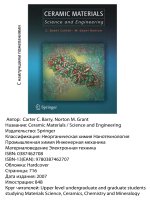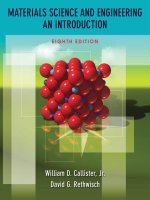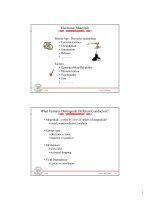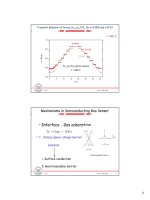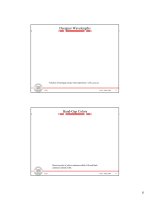materials science and engineering an introduction, 7th edition
Bạn đang xem bản rút gọn của tài liệu. Xem và tải ngay bản đầy đủ của tài liệu tại đây (24.05 MB, 975 trang )
Materials Science and Engineering
An Introduction
1496T_fm_i-xxvi 1/6/06 02:56 Page iii
John Wiley & Sons, Inc.
Materials Science
and Engineering
An Introduction
William D. Callister, Jr.
Department of Metallurgical Engineering
The University of Utah
with special contributions by
David G. Rethwisch
The University of Iowa
S
EVENTH
E
DITION
1496T_fm_i-xxvi 1/6/06 22:25 Page v
Front Cover: A unit cell for diamond (blue-gray spheres represent carbon atoms), which is positioned
above the temperature-versus-logarithm pressure phase diagram for carbon; highlighted in blue is the
region for which diamond is the stable phase.
Back Cover: Atomic structure for graphite; here the gray spheres depict carbon atoms. The region of
graphite stability is highlighted in orange on the pressure-temperature phase diagram for carbon,
which is situated behind this graphite structure.
ACQUISITIONS EDITOR Joseph Hayton
MARKETING DIRECTOR Frank Lyman
SENIOR PRODUCTION EDITOR Ken Santor
SENIOR DESIGNER Kevin Murphy
COVER ART Roy Wiemann
TEXT DESIGN Michael Jung
SENIOR ILLUSTRATION EDITOR Anna Melhorn
COMPOSITOR Techbooks/GTS,York, PA
ILLUSTRATION STUDIO Techbooks/GTS, York, PA
This book was set in 10/12 Times Ten by Techbooks/GTS, York, PA and printed and bound by
Quebecor Versailles. The cover was printed by Quebecor.
This book is printed on acid free paper.
Copyright © 2007 John Wiley & Sons, Inc. All rights reserved.
No part of this publication may be reproduced, stored in a retrieval system or transmitted in any form
or by any means, electronic, mechanical, photocopying, recording, scanning or otherwise, except as
permitted under Sections 107 or 108 of the 1976 United States Copyright Act, without either the prior
written permission of the Publisher, or authorization through payment of the appropriate per-copy fee
to the Copyright Clearance Center, 222 Rosewood Drive, Danvers, MA 01923, (508)750-8400, fax
(508)750-4470. Requests to the Publisher for permission should be addressed to the Permissions
Department, John Wiley & Sons, Inc., 605 Third Avenue, New York, NY 10158-0012, (212) 850-6011,
fax (212) 850-6008, E-Mail:
To order books or for customer service please call 1(800)225-5945.
Library of Congress Cataloging-in-Publication Data
Callister, William D., 1940-
Materials science and engineering : an introduction / William D. Callister, Jr.—7th ed.
p. cm.
Includes bibliographical references and index.
ISBN-13: 978-0-471-73696-7 (cloth)
ISBN-10: 0-471-73696-1 (cloth)
1. Materials. I. Title.
TA403.C23 2007
620.1’1—dc22
2005054228
Printed in the United States of America
10 9 8 7 6 5 4 3 2 1
1496T_fm_i-xxvi 1/11/06 23:05 Page vi
Dedicated to
my colleagues and friends in Brazil and Spain
1496T_fm_i-xxvi 1/6/06 02:56 Page vii
1496T_fm_i-xxvi 1/6/06 02:56 Page viii
• xv
Contents
L
IST OF
S
YMBOLS
xxiii
1. Introduction 1
Learning Objectives 2
1.1 Historical Perspective 2
1.2 Materials Science and Engineering 3
1.3 Why Study Materials Science and Engineering? 5
1.4 Classification of Materials 5
1.5 Advanced Materials 11
1.6 Modern Materials’ Needs 12
References 13
2. Atomic Structure and Interatomic Bonding 15
Learning Objectives 16
2.1 Introduction 16
A
TOMIC
S
TRUCTURE
16
2.2 Fundamental Concepts 16
2.3 Electrons in Atoms 17
2.4 The Periodic Table 23
A
TOMIC
B
ONDING IN
S
OLIDS
24
2.5 Bonding Forces and Energies 24
2.6 Primary Interatomic Bonds 26
2.7 Secondary Bonding or van der Waals Bonding 30
2.8 Molecules 32
Summary 34
Important Terms and Concepts 34
References 35
Questions and Problems 35
3. The Structure of Crystalline Solids 38
Learning Objectives 39
3.1 Introduction 39
C
RYSTAL
S
TRUCTURES
39
3.2 Fundamental Concepts 39
3.3 Unit Cells 40
3.4 Metallic Crystal Structures 41
3.5 Density Computations 45
3.6 Polymorphism and Allotropy 46
1496T_fm_i-xxvi 1/6/06 03:19 Page xv
3.7 Crystal Systems 46
C
RYSTALLOGRAPHIC
P
OINTS
, D
IRECTIONS
,
AND
P
LANES
49
3.8 Point Coordinates 49
3.9 Crystallographic Directions 51
3.10 Crystallographic Planes 55
3.11 Linear and Planar Densities 60
3.12 Close-Packed Crystal Structures 61
C
RYSTALLINE AND
N
ONCRYSTALLINE
M
ATERIALS
63
3.13 Single Crystals 63
3.14 Polycrystalline Materials 64
3.15 Anisotropy 64
3.16 X-Ray Diffraction: Determination of
Crystal Structures 66
3.17 Noncrystalline Solids 71
Summary 72
Important Terms and Concepts 73
References 73
Questions and Problems 74
4. Imperfections in Solids 80
Learning Objectives 81
4.1 Introduction 81
P
OINT
D
EFECTS
81
4.2 Vacancies and Self-Interstitials 81
4.3 Impurities in Solids 83
4.4 Specification of Composition 85
M
ISCELLANEOUS
I
MPERFECTIONS
88
4.5 Dislocations–Linear Defects 88
4.6 Interfacial Defects 92
4.7 Bulk or Volume Defects 96
4.8 Atomic Vibrations 96
M
ICROSCOPIC
E
XAMINATION
97
4.9 General 97
4.10 Microscopic Techniques 98
4.11 Grain Size Determination 102
Summary 104
Important Terms and Concepts 105
References 105
Questions and Problems 106
Design Problems 108
5. Diffusion 109
Learning Objectives 110
5.1 Introduction 110
5.2 Diffusion Mechanisms 111
5.3 Steady-State Diffusion 112
5.4 Nonsteady-State Diffusion 114
5.5 Factors That Influence Diffusion 118
5.6 Other Diffusion Paths 125
Summary 125
Important Terms and Concepts 126
References 126
Questions and Problems 126
Design Problems 129
6. Mechanical Properties of Metals 131
Learning Objectives 132
6.1 Introduction 132
6.2 Concepts of Stress and Strain 133
E
LASTIC
D
EFORMATION
137
6.3 Stress-Strain Behavior 137
6.4 Anelasticity 140
6.5 Elastic Properties of Materials 141
P
LASTIC
D
EFORMATION
143
6.6 Tensile Properties 144
6.7 True Stress and Strain 151
6.8 Elastic Recovery after Plastic
Deformation 154
6.9 Compressive, Shear, and Torsional
Deformation 154
6.10 Hardness 155
P
ROPERTY
V
ARIABILITY AND
D
ESIGN
/S
AFETY
F
ACTORS
161
6.11 Variability of Material Properties 161
6.12 Design/Safety Factors 163
Summary 165
Important Terms and Concepts 166
References 166
Questions and Problems 166
Design Problems 172
7. Dislocations and Strengthening
Mechanisms 174
Learning Objectives 175
7.1 Introduction 175
D
ISLOCATIONS AND
P
LASTIC
D
EFORMATION
175
7.2 Basic Concepts 175
7.3 Characteristics of Dislocations 178
7.4 Slip Systems 179
7.5 Slip in Single Crystals 181
7.6 Plastic Deformation of Polycrystalline
Materials 185
7.7 Deformation by Twinning 185
xvi • Contents
1496T_fm_i-xxvi 1/6/06 02:56 Page xvi
M
ECHANISMS OF
S
TRENGTHENING
IN
M
ETALS
188
7.8 Strengthening by Grain Size
Reduction 188
7.9 Solid-Solution Strengthening 190
7.10 Strain Hardening 191
R
ECOVERY
, R
ECRYSTALLIZATION
,
AND
G
RAIN
G
ROWTH
194
7.11 Recovery 195
7.12 Recrystallization 195
7.13 Grain Growth 200
Summary 201
Important Terms and Concepts 202
References 202
Questions and Problems 202
Design Problems 206
8. Failure 207
Learning Objectives 208
8.1 Introduction 208
F
RACTURE
208
8.2 Fundamentals of Fracture 208
8.3 Ductile Fracture 209
8.4 Brittle Fracture 211
8.5 Principles of Fracture Mechanics 215
8.6 Impact Fracture Testing 223
F
ATIGUE
227
8.7 Cyclic Stresses 228
8.8 The S–N Curve 229
8.9 Crack Initiation and Propagation 232
8.10 Factors That Affect Fatigue Life 234
8.11 Environmental Effects 237
C
REEP
238
8.12 Generalized Creep Behavior 238
8.13 Stress and Temperature Effects 239
8.14 Data Extrapolation Methods 241
8.15 Alloys for High-Temperature
Use 242
Summary 243
Important Terms and Concepts 245
References 246
Questions and Problems 246
Design Problems 250
9. Phase Diagrams 252
Learning Objectives 253
9.1 Introduction 253
D
EFINITIONS AND
B
ASIC
C
ONCEPTS
253
Contents • xvii
9.2 Solubility Limit 254
9.3 Phases 254
9.4 Microstructure 255
9.5 Phase Equilibria 255
9.6 One-Component (or Unary) Phase
Diagrams 256
B
INARY
P
HASE
D
IAGRAMS
258
9.7 Binary Isomorphous Systems 258
9.8 Interpretation of Phase Diagrams 260
9.9 Development of Microstructure in
Isomorphous Alloys 264
9.10 Mechanical Properties of Isomorphous
Alloys 268
9.11 Binary Eutectic Systems 269
9.12 Development of Microstructure in
Eutectic Alloys 276
9.13 Equilibrium Diagrams Having
Intermediate Phases or
Compounds 282
9.14 Eutectic and Peritectic Reactions 284
9.15 Congruent Phase
Transformations 286
9.16 Ceramic and Ternary Phase
Diagrams 287
9.17 The Gibbs Phase Rule 287
T
HE
I
RON
–C
ARBON
S
YSTEM
290
9.18 The Iron–Iron Carbide (Fe–Fe
3
C) Phase
Diagram 290
9.19 Development of Microstructure in
Iron–Carbon Alloys 293
9.20 The Influence of Other Alloying
Elements 301
Summary 302
Important Terms and Concepts 303
References 303
Questions and Problems 304
10. Phase Transformations in Metals:
Development of Microstructure
and Alteration of Mechanical
Properties 311
Learning Objectives 312
10.1 Introduction 312
P
HASE
T
RANSFORMATIONS
312
10.2 Basic Concepts 312
10.3 The Kinetics of Phase
Transformations 313
10.4 Metastable versus Equilibrium
States 324
1496T_fm_i-xxvi 01/10/06 22:13 Page xvii
xviii • Contents
M
ICROSTRUCTURAL AND
P
ROPERTY
C
HANGES IN
I
RON
–C
ARBON
A
LLOYS
324
10.5 Isothermal Transformation Diagrams 325
10.6 Continuous Cooling Transformation
Diagrams 335
10.7 Mechanical Behavior of Iron–Carbon
Alloys 339
10.8 Tempered Martensite 343
10.9 Review of Phase Transformations and
Mechanical Properties for Iron–Carbon
Alloys 346
Summary 350
Important Terms and Concepts 351
References 352
Questions and Problems 352
Design Problems 356
11. Applications and Processing of
Metal Alloys 358
Learning Objectives 359
11.1 Introduction 359
T
YPES OF
M
ETAL
A
LLOYS
359
11.2 Ferrous Alloys 359
11.3 Nonferrous Alloys 372
F
ABRICATION OF
M
ETALS
382
11.4 Forming Operations 383
11.5 Casting 384
11.6 Miscellaneous Techniques 386
T
HERMAL
P
ROCESSING OF
M
ETALS
387
11.7 Annealing Processes 388
11.8 Heat Treatment of Steels 390
11.9 Precipitation Hardening 402
Summary 407
Important Terms and Concepts 409
References 409
Questions and Problems 410
Design Problems 411
12. Structures and Properties of
Ceramics 414
Learning Objectives 415
12.1 Introduction 415
C
ERAMIC
S
TRUCTURES
415
12.2 Crystal Structures 415
12.3 Silicate Ceramics 426
12.4 Carbon 430
12.5 Imperfections in Ceramics 434
12.6 Diffusion in Ionic Materials 438
12.7 Ceramic Phase Diagrams 439
M
ECHANICAL
P
ROPERTIES
442
12.8 Brittle Fracture of Ceramics 442
12.9 Stress–Strain Behavior 447
12.10 Mechanisms of Plastic
Deformation 449
12.11 Miscellaneous Mechanical
Considerations 451
Summary 453
Important Terms and Concepts 454
References 454
Questions and Problems 455
Design Problems 459
13. Applications and Processing of
Ceramics 460
Learning Objectives 461
13.1 Introduction 461
T
YPES AND
A
PPLICATIONS OF
C
ERAMICS
461
13.2 Glasses 461
13.3 Glass–Ceramics 462
13.4 Clay Products 463
13.5 Refractories 464
13.6 Abrasives 466
13.7 Cements 467
13.8 Advanced Ceramics 468
F
ABRICATION AND
P
ROCESSING OF
C
ERAMICS
471
13.9 Fabrication and Processing of Glasses
and Glass–Ceramics 471
13.10 Fabrication and Processing of Clay
Products 476
13.11 Powder Pressing 481
13.12 Tape Casting 484
Summary 484
Important Terms and Concepts 486
References 486
Questions and Problems 486
Design Problem 488
14. Polymer Structures 489
Learning Objectives 490
14.1 Introduction 490
14.2 Hydrocarbon Molecules 490
14.3 Polymer Molecules 492
14.4 The Chemistry of Polymer
Molecules 493
14.5 Molecular Weight 497
1496T_fm_i-xxvi 01/10/06 22:13 Page xviii
Contents • xix
14.6 Molecular Shape 500
14.7 Molecular Structure 501
14.8 Molecular Configurations 503
14.9 Thermoplastic and Thermosetting
Polymers 506
14.10 Copolymers 507
14.11 Polymer Crystallinity 508
14.12 Polymer Crystals 512
14.13 Defects in Polymers 514
14.14 Diffusion in Polymeric Materials 515
Summary 517
Important Terms and Concepts 519
References 519
Questions and Problems 519
15. Characteristics, Applications, and
Processing of Polymers 523
Learning Objectives 524
15.1 Introduction 524
M
ECHANICAL
B
EHAVIOR OF
P
OLYMERS
524
15.2 Stress–Strain Behavior 524
15.3 Macroscopic Deformation 527
15.4 Viscoelastic Deformation 527
15.5 Fracture of Polymers 532
15.6 Miscellaneous Mechanical
Characteristics 533
M
ECHANISMS OF
D
EFORMATION AND FOR
S
TRENGTHENING OF
P
OLYMERS
535
15.7 Deformation of Semicrystalline
Polymers 535
15.8 Factors That Influence the Mechanical
Properties of Semicrystalline
Polymers 538
15.9 Deformation of Elastomers 541
C
RYSTALLIZATION
, M
ELTING
,
AND
G
LASS
T
RANSITION
P
HENOMENA IN
P
OLYMERS
544
15.10 Crystallization 544
15.11 Melting 545
15.12 The Glass Transition 545
15.13 Melting and Glass Transition
Temperatures 546
15.14 Factors That Influence Melting and Glass
Transition Temperatures 547
P
OLYMER
T
YPES
549
15.15 Plastics 549
15.16 Elastomers 552
15.17 Fibers 554
15.18 Miscellaneous Applications 555
15.19 Advanced Polymeric Materials 556
P
OLYMER
S
YNTHESIS AND
P
ROCESSING
560
15.20 Polymerization 561
15.21 Polymer Additives 563
15.22 Forming Techniques for Plastics 565
15.23 Fabrication of Elastomers 567
15.24 Fabrication of Fibers and Films 568
Summary 569
Important Terms and Concepts 571
References 571
Questions and Problems 572
Design Questions 576
16. Composites 577
Learning Objectives 578
16.1 Introduction 578
P
ARTICLE
-R
EINFORCED
C
OMPOSITES
580
16.2 Large-Particle Composites 580
16.3 Dispersion-Strengthened
Composites 584
F
IBER
-R
EINFORCED
C
OMPOSITES
585
16.4 Influence of Fiber Length 585
16.5 Influence of Fiber Orientation and
Concentration 586
16.6 The Fiber Phase 595
16.7 The Matrix Phase 596
16.8 Polymer-Matrix Composites 597
16.9 Metal-Matrix Composites 603
16.10 Ceramic-Matrix Composites 605
16.11 Carbon–Carbon Composites 606
16.12 Hybrid Composites 607
16.13 Processing of Fiber-Reinforced
Composites 607
S
TRUCTURAL
C
OMPOSITES
610
16.14 Laminar Composites 610
16.15 Sandwich Panels 611
Summary 613
Important Terms and Concepts 615
References 616
Questions and Problems 616
Design Problems 619
17. Corrosion and Degradation of
Materials 621
Learning Objectives 622
17.1 Introduction 622
C
ORROSION OF
M
ETALS
622
17.2 Electrochemical Considerations 623
17.3 Corrosion Rates 630
1496T_fm_i-xxvi 01/10/06 22:13 Page xix
xx • Contents
17.4 Prediction of Corrosion Rates 631
17.5 Passivity 638
17.6 Environmental Effects 640
17.7 Forms of Corrosion 640
17.8 Corrosion Environments 648
17.9 Corrosion Prevention 649
17.10 Oxidation 651
C
ORROSION OF
C
ERAMIC
M
ATERIALS
654
D
EGRADATION OF
P
OLYMERS
655
17.11 Swelling and Dissolution 655
17.12 Bond Rupture 657
17.13 Weathering 658
Summary 659
Important Terms and Concepts 660
References 661
Questions and Problems 661
Design Problems 644
18. Electrical Properties 665
Learning Objectives 666
18.1 Introduction 666
E
LECTRICAL
C
ONDUCTION
666
18.2 Ohm’s Law 666
18.3 Electrical Conductivity 667
18.4 Electronic and Ionic Conduction 668
18.5 Energy Band Structures in
Solids 668
18.6 Conduction in Terms of Band and
Atomic Bonding Models 671
18.7 Electron Mobility 673
18.8 Electrical Resistivity of Metals 674
18.9 Electrical Characteristics of Commercial
Alloys 677
S
EMICONDUCTIVITY
679
18.10 Intrinsic Semiconduction 679
18.11 Extrinsic Semiconduction 682
18.12 The Temperature Dependence of Carrier
Concentration 686
18.13 Factors That Affect Carrier Mobility 688
18.14 The Hall Effect 692
18.15 Semiconductor Devices 694
E
LECTRICAL
C
ONDUCTION IN
I
ONIC
C
ERAMICS
AND IN
P
OLYMERS
700
18.16 Conduction in Ionic Materials 701
18.17 Electrical Properties of Polymers 701
D
IELECTRIC
B
EHAVIOR
702
18.18 Capacitance 703
18.19 Field Vectors and Polarization 704
18.20 Types of Polarization 708
18.21 Frequency Dependence of the Dielectric
Constant 709
18.22 Dielectric Strength 711
18.23 Dielectric Materials 711
O
THER
E
LECTRICAL
C
HARACTERISTICS OF
M
ATERIALS
711
18.24 Ferroelectricity 711
18.25 Piezoelectricity 712
Summary 713
Important Terms and Concepts 715
References 715
Questions and Problems 716
Design Problems 720
19. Thermal Properties W1
Learning Objectives W2
19.1 Introduction W2
19.2 Heat Capacity W2
19.3 Thermal Expansion W4
19.4 Thermal Conductivity W7
19.5 Thermal Stresses W12
Summary W14
Important Terms and Concepts W15
References W15
Questions and Problems W15
Design Problems W17
20. Magnetic Properties W19
Learning Objectives W20
20.1 Introduction W20
20.2 Basic Concepts W20
20.3 Diamagnetism and
Paramagnetism W24
20.4 Ferromagnetism W26
20.5 Antiferromagnetism and
Ferrimagnetism W28
20.6 The Influence of Temperature on
Magnetic Behavior W32
20.7 Domains and Hysteresis W33
20.8 Magnetic Anisotropy W37
20.9 Soft Magnetic Materials W38
20.10 Hard Magnetic Materials W41
20.11 Magnetic Storage W44
20.12 Superconductivity W47
Summary W50
Important Terms and Concepts W52
References W52
Questions and Problems W53
Design Problems W56
1496T_fm_i-xxvi 01/10/06 22:13 Page xx
Contents • xxi
21. Optical Properties W57
Learning Objectives W58
21.1 Introduction W58
B
ASIC
C
ONCEPTS
W58
21.2 Electromagnetic Radiation W58
21.3 Light Interactions with Solids W60
21.4 Atomic and Electronic
Interactions W61
O
PTICAL
P
ROPERTIES OF
M
ETALS
W62
O
PTICAL
P
ROPERTIES OF
N
ONMETALS
W63
21.5 Refraction W63
21.6 Reflection W65
21.7 Absorption W65
21.8 Transmission W68
21.9 Color W69
21.10 Opacity and Translucency in
Insulators W71
A
PPLICATIONS OF
O
PTICAL
P
HENOMENA
W72
21.11 Luminescence W72
21.12 Photoconductivity W72
21.13 Lasers W75
21.14 Optical Fibers in Communications W79
Summary W82
Important Terms and Concepts W83
References W84
Questions and Problems W84
Design Problem W85
22. Materials Selection and Design
Considerations W86
Learning Objectives W87
22.1 Introduction W87
M
ATERIALS
S
ELECTION FOR A
T
ORSIONALLY
S
TRESSED
C
YLINDRICAL
S
HAFT
W87
22.2 Strength Considerations–Torsionally
Stressed Shaft W88
22.3 Other Property Considerations and the
Final Decision W93
A
UTOMOTIVE
V
ALVE
S
PRING
W94
22.4 Mechanics of Spring Deformation W94
22.5 Valve Spring Design and Material
Requirements W95
22.6 One Commonly Employed Steel
Alloy W98
F
AILURE OF AN
A
UTOMOBILE
R
EAR
A
XLE
W101
22.7 Introduction W101
22.8 Testing Procedure and Results W102
22.9 Discussion W108
A
RTIFICIAL
T
OTAL
H
IP
R
EPLACEMENT
W108
22.10 Anatomy of the Hip Joint W108
22.11 Material Requirements W111
22.12 Materials Employed W112
C
HEMICAL
P
ROTECTIVE
C
LOTHING
W115
22.13 Introduction W115
22.14 Assessment of CPC Glove Materials to
Protect Against Exposure to Methylene
Chloride W115
M
ATERIALS FOR
I
NTEGRATED
C
IRCUIT
P
ACKAGES
W119
22.15 Introduction W119
22.16 Leadframe Design and Materials W120
22.17 Die Bonding W121
22.18 Wire Bonding W124
22.19 Package Encapsulation W125
22.20 Tape Automated Bonding W127
Summary W129
References W130
Design Questions and Problems W131
23. Economic, Environmental, and
Societal Issues in Materials Science
and Engineering W135
Learning Objectives W136
23.1 Introduction W136
E
CONOMIC
C
ONSIDERATIONS
W136
23.2 Component Design W137
23.3 Materials W137
23.4 Manufacturing Techniques W137
E
NVIRONMENTAL AND
S
OCIETAL
C
ONSIDERATIONS
W137
23.5 Recycling Issues in Materials Science and
Engineering W140
Summary W143
References W143
Design Question W144
Appendix A The International System of
Units A1
Appendix B Properties of Selected
Engineering Materials A3
B.1 Density A3
B.2 Modulus of Elasticity A6
B.3 Poisson’s Ratio A10
1496T_fm_i-xxvi 01/10/06 22:13 Page xxi
xxii • Contents
B.4 Strength and Ductility A11
B.5 Plane Strain Fracture Toughness A16
B.6 Linear Coefficient of Thermal
Expansion A17
B.7 Thermal Conductivity A21
B.8 Specific Heat A24
B.9 Electrical Resistivity A26
B.10 Metal Alloy Compositions A29
Appendix C Costs and Relative Costs for
Selected Engineering Materials A31
Appendix D Repeat Unit Structures for
Common Polymers A37
Appendix E Glass Transition and Melting
Temperatures for Common Polymeric
Materials A41
Glossary G0
Answers to Selected Problems S1
Index I1
1496T_fm_i-xxvi 01/10/06 22:13 Page xxii
• ix
Preface
In this Seventh Edition I have retained the objectives and approaches for teaching
materials science and engineering that were presented in previous editions. The first,
and primary, objective is to present the basic fundamentals on a level appropriate for
university/college students who have completed their freshmen calculus,chemistry, and
physics courses. In order to achieve this goal, I have endeavored to use terminology
that is familiar to the student who is encountering the discipline of materials science
and engineering for the first time, and also to define and explain all unfamiliar terms.
The second objective is to present the subject matter in a logical order, from the
simple to the more complex. Each chapter builds on the content of previous ones.
The third objective, or philosophy, that I strive to maintain throughout the text
is that if a topic or concept is worth treating, then it is worth treating in sufficient
detail and to the extent that students have the opportunity to fully understand it
without having to consult other sources; also, in most cases, some practical relevance
is provided. Discussions are intended to be clear and concise and to begin at
appropriate levels of understanding.
The fourth objective is to include features in the book that will expedite the
learning process. These learning aids include:
• Numerous illustrations, now presented in full color, and photographs to
help visualize what is being presented;
• Learning objectives;
• “Why Study . . .” and “Materials of Importance” items that provide rele-
vance to topic discussions;
• Key terms and descriptions of key equations highlighted in the margins for
quick reference;
• End-of-chapter questions and problems;
• Answers to selected problems;
• A glossary, list of symbols, and references to facilitate understanding the
subject matter.
The fifth objective is to enhance the teaching and learning process by using
the newer technologies that are available to most instructors and students of
engineering today.
F
EATURES
T
HAT
A
RE
N
EW TO
T
HIS
E
DITION
New/Revised Content
Several important changes have been made with this Seventh Edition. One of
the most significant is the incorporation of a number of new sections, as well
1496T_fm_i-xxvi 1/6/06 02:56 Page ix
as revisions/amplifications of other sections. New sections/discussions are as
follows:
• One-component (or unary) phase diagrams (Section 9.6)
• Compacted graphite iron (in Section 11.2, “Ferrous Alloys”)
• Lost foam casting (in Section 11.5, “Casting”)
• Temperature dependence of Frenkel and Schottky defects (in Section 12.5,
“Imperfections in Ceramics”)
• Fractography of ceramics (in Section 12.8, “Brittle Fracture of Ceramics”)
• Crystallization of glass-ceramics, in terms of isothermal transformation
and continuous cooling transformation diagrams (in Section 13.3,
“Glass-Ceramics”)
• Permeability in polymers (in Section 14.14, “Diffusion in Polymeric
Materials”)
• Magnetic anisotropy (Section 20.8)
• A new case study on chemical protective clothing (Sections 22.13 and
22.14).
Those sections that have been revised/amplified, include the following:
• Treatments in Chapter 1 (“Introduction”) on the several material types
have been enlarged to include comparisons of various property values (as
bar charts).
• Expanded discussions on crystallographic directions and planes in hexagonal
crystals (Sections 3.9 and 3.10); also some new related homework problems.
• Comparisons of (1) dimensional size ranges for various structural elements,
and (2) resolution ranges for the several microscopic examination tech-
niques (in Section 4.10, “Microscopic Techniques”).
• Updates on hardness testing techniques (Section 6.10).
• Revised discussion on the Burgers vector (Section 7.4).
• New discussion on why recrystallization temperature depends on the purity
of a metal (Section 7.12).
• Eliminated some detailed discussion on fracture mechanics—i.e., used
“Concise Version” from sixth edition (Section 8.5).
• Expanded discussion on nondestructive testing (Section 8.5).
• Used Concise Version (from sixth edition) of discussion on crack initiation
and propagation (for fatigue, Section 8.9), and eliminated section on crack
propagation rate.
• Refined terminology and representations of polymer structures (Sections
14.3 through 14.8).
• Eliminated discussion on fringed-micelle model (found in Section 14.12 of
the sixth edition).
• Enhanced discussion on defects in polymers (Section 14.13).
• Revised the following sections in Chapter 15 (“Characteristics, Applica-
tions, and Processing of Polymers”): fracture of polymers (Section 15.5),
deformation of semicrystalline polymers (Section 15.7), adhesives (in
Section 15.18), polymerization (Section 15.20), and fabrication of fibers and
films (Section 15.24).
• Revised treatment of polymer degradation (Section 17.12).
x • Preface
1496T_fm_i-xxvi 01/10/06 22:13 Page x
Materials of Importance
One new feature that has been incorporated in this edition is “Materials of Im-
portance” pieces; in these we discuss familiar and interesting materials/applications
of materials. These pieces lend some relevance to topical coverage, are found in
most chapters in the book, and include the following:
• Carbonated Beverage Containers
• Water (Its Volume Expansion Upon Freezing)
• Tin (Its Allotropic Transformation)
• Catalysts (and Surface Defects)
• Aluminum for Integrated Circuit Interconnects
• Lead-Free Solders
• Shape-Memory Alloys
• Metal Alloys Used for Euro Coins
• Carbon Nanotubes
• Piezoelectric Ceramics
• Shrink-Wrap Polymer Films
• Phenolic Billiard Balls
• Nanocomposites in Tennis Balls
• Aluminum Electrical Wires
• Invar and Other Low-Expansion Alloys
• An Iron-Silicon Alloy That is Used in Transformer Cores
• Light-Emitting Diodes
Concept Check
Another new feature included in this seventh edition is what we call a “Concept
Check,” a question that tests whether or not a student understands the subject mat-
ter on a conceptual level. Concept check questions are found within most chap-
ters; many of them appeared in the end-of-chapter Questions and Problems sections
of the previous edition. Answers to these questions are on the book’s Web site,
www.wiley.com/college/callister (Student Companion Site).
And, finally, for each chapter, both the Summary and the Questions and Prob-
lems are organized by section; section titles precede their summaries and ques-
tions/problems.
Format Changes
There are several other major changes from the format of the sixth edition. First of
all, no CD-ROM is packaged with the in-print text; all electronic components are
found on the book’s Web site (www.wiley.com/college/callister). This includes the
last five chapters in the book—viz. Chapter 19, “Thermal Properties;” Chapter 20,
“Magnetic Properties;” Chapter 21, “Optical Properties;” Chapter 22, “Materials
Selection and Design Considerations;” and Chapter 23, “Economic, Environmental,
and Societal Issues in Materials Science and Engineering.” These chapters are in
Adobe Acrobat
®
pdf format and may be downloaded.
Furthermore, only complete chapters appear on the Web site (rather than se-
lected sections for some chapters per the sixth edition).And, in addition, for all sec-
tions of the book there is only one version—for the two-version sections of the sixth
edition, in most instances, the detailed ones have been retained.
Preface • xi
1496T_fm_i-xxvi 01/10/06 22:13 Page xi
Six case studies have been relegated to Chapter 22, “Materials Selection and
Design Considerations,” which are as follows:
• Materials Selection for a Torsionally Stressed Cylindrical Shaft
• Automobile Valve Spring
• Failure of an Automobile Rear Axle
• Artificial Total Hip Replacement
• Chemical Protective Clothing
• Materials for Integrated Circuit Packages
References to these case studies are made in the left-page margins at appropriate
locations in the other chapters.All but “Chemical Protective Clothing” appeared in
the sixth edition; it replaces the “Thermal Protection System on the Space Shuttle
Orbiter” case study.
S
TUDENT
L
EARNING
R
ESOURCES
(
WWW
.
WILEY
.
COM
/
COLLEGE
/
CALLISTER
)
Also found on the book’s Web site (under “Student Companion Site”) are several
important instructional elements for the student that complement the text; these
include the following:
1. VMSE: Virtual Materials Science and Engineering. This is essentially the
same software program that accompanied the previous edition, but now browser-
based for easier use on a wider variety of computer platforms. It consists of in-
teractive simulations and animations that enhance the learning of key concepts
in materials science and engineering, and, in addition, a materials properties/cost
database. Students can access VMSE via the registration code included with all
new copies.
Throughout the book, whenever there is some text or a problem that is sup-
plemented by VMSE, a small “icon” that denotes the associated module is in-
cluded in one of the margins. These modules and their corresponding icons are as
follows:
Metallic Crystal Structures
Phase Diagrams
and Crystallography
Ceramic Crystal Structures Diffusion
Repeat Unit and Polymer
Tensile Tests
Structures
Dislocations Solid-Solution Strengthening
2. Answers to the Concept Check questions.
3. Direct access to online self-assessment exercises. This is a Web-based assess-
ment program that contains questions and problems similar to those found in the
text; these problems/questions are organized and labeled according to textbook
sections. An answer/solution that is entered by the user in response to a ques-
tion/problem is graded immediately, and comments are offered for incorrect re-
sponses.The student may use this electronic resource to review course material, and
to assess his/her mastery and understanding of topics covered in the text.
xii • Preface
1496T_fm_i-xxvi 01/10/06 22:13 Page xii
4. Additional Web resources, which include the following:
• Index of Learning Styles. Upon answering a 44-item questionnaire, a user’s
learning style preference (i.e., the manner in which information is assimi-
lated and processed) is assessed.
• Extended Learning Objectives. A more extensive list of learning objectives
than is provided at the beginning of each chapter.
• Links to Other Web Resources. These links are categorized according to
general Internet, software, teaching, specific course content/activities, and
materials databases.
I
NSTRUCTORS
’ R
ESOURCES
The “Instructor Companion Site” (www.wiley.com/college/callister) is available for
instructors who have adopted this text. Resources that are available include the
following:
1. Detailed solutions of all end-of-chapter questions and problems (in both
Microsoft Word
®
and Adobe Acrobat
®
PDF formats).
2. Photographs, illustrations, and tables that appear in the book (in PDF and
JPEG formats); an instructor can print them for handouts or prepare transparen-
cies in his/her desired format.
3. A set of PowerPoint
®
lecture slides developed by Peter M. Anderson (The
Ohio State University) and David G. Rethwisch (The University of Iowa). These
slides follow the flow of topics in the text, and include materials from the text and
other sources as well as illustrations and animations. Instructors may use the slides
as is or edit them to fit their teaching needs.
4. A list of classroom demonstrations and laboratory experiments that portray
phenomena and/or illustrate principles that are discussed in the book; references
are also provided that give more detailed accounts of these demonstrations.
5. Suggested course syllabi for the various engineering disciplines.
WileyPLUS
WileyPLUS gives you, the instructor, the technology to create an environment where
students reach their full potential and experience academic success that will last a
lifetime! With WileyPLUS, students will come to class better prepared for your lec-
tures,get immediate feedback and context-sensitive help on assignments and quizzes,
and have access to a full range of interactive learning resources including a com-
plete online version of their text. WileyPLUS gives you a wealth of presentation and
preparation tools, easy-to-navigate assessment tools including an online gradebook,
and a complete system to administer and manage your course exactly as you wish.
Contact your local Wiley representative for details on how to set up your WileyPLUS
course, or visit the website at www.wiley.com/college/wileyplus.
F
EEDBACK
I have a sincere interest in meeting the needs of educators and students in the
materials science and engineering community, and therefore would like to solicit
feedback on this seventh edition. Comments, suggestions, and criticisms may be
submitted to me via e-mail at the following address:
A
CKNOWLEDGMENTS
Appreciation is expressed to those who have made contributions to this edition.
I am especially indebted to David G. Rethwisch, who, as a special contributor,
Preface • xiii
1496T_fm_i-xxvi 1/6/06 02:56 Page xiii
provided invaluable assistance in updating and upgrading important material in a
number of chapters. In addition, I sincerely appreciate Grant E. Head’s expert pro-
gramming skills, which he used in developing the Virtual Materials Science and En-
gineering software. Important input was also furnished by Carl Wood of Utah State
University and W. Roger Cannon of Rutgers University, to whom I also give thanks.
In addition, helpful ideas and suggestions have been provided by the following:
xiv • Preface
Tarek Abdelsalam, East Carolina University
Keyvan Ahdut, University of the District of
Columbia
Mark Aindow, University of Connecticut (Storrs)
Pranesh Aswath, University of Texas at Arlington
Mir Atiqullah, St. Louis University
Sayavur Bakhtiyarov, Auburn University
Kristen Constant, Iowa State University
Raymond Cutler, University of Utah
Janet Degrazia, University of Colorado
Mark DeGuire, Case Western Reserve University
Timothy Dewhurst, Cedarville University
Amelito Enriquez, Canada College
Jeffrey Fergus, Auburn University
Victor Forsnes, Brigham Young University (Idaho)
Paul Funkenbusch, University of Rochester
Randall German, Pennsylvania State University
Scott Giese, University of Northern Iowa
Brian P. Grady, University of Oklahoma
Theodore Greene, Wentworth Institute of
Technology
Todd Gross, University of New Hampshire
Jamie Grunlan, Texas A & M University
Masanori Hara, Rutgers University
Russell Herlache, Saginaw Valley State University
Susan Holl, California State University
(Sacramento)
Zhong Hu, South Dakota State University
Duane Jardine, University of New Orleans
Jun Jin, Texas A & M University at Galveston
Paul Johnson, Grand Valley State University
Robert Johnson, University of Texas at Arlington
Robert Jones, University of Texas (Pan American)
Maureen Julian, Virginia Tech
James Kawamoto, Mission College
Edward Kolesar, Texas Christian University
Stephen Krause, Arizona State University (Tempe)
Robert McCoy, Youngstown State University
Scott Miller, University of Missouri (Rolla)
Devesh Misra, University of Louisiana at
Lafayette
Angela L. Moran, U.S. Naval Academy
James Newell, Rowan University
Toby Padilla, Colorado School of Mines
Timothy Raymond, Bucknell University
Alessandro Rengan, Central State University
Bengt Selling, Royal Institute of Technology
(Stockholm, Sweden)
Ismat Shah, University of Delaware
Patricia Shamamy, Lawrence Technological
University
Adel Sharif, California State University at
Los Angeles
Susan Sinnott, University of Florida
Andrey Soukhojak, Lehigh University
Erik Spjut, Harvey Mudd College
David Stienstra, Rose-Hulman Institute of
Technology
Alexey Sverdlin, Bradley University
Dugan Um, Texas State University
Raj Vaidyanatha, University of Central Florida
Kant Vajpayee, University of Southern Mississippi
Kumar Virwani, University of Arkansas
(Fayetteville)
Mark Weaver, University of Alabama (Tuscaloosa)
Jason Weiss, Purdue University (West Lafayette)
I am also indebted to Joseph P. Hayton,Sponsoring Editor,and to Kenneth Santor,
Senior Production Editor at Wiley for their assistance and guidance on this revision.
Since I undertook the task of writing my first text on this subject in the early-
80’s, instructors and students too numerous to mention have shared their input and
contributions on how to make this work more effective as a teaching and learning
tool. To all those who have helped, I express my sincere “Thanks!”
Last, but certainly not least, the continual encouragement and support of my
family and friends is deeply and sincerely appreciated.
W
ILLIAM
D. C
ALLISTER
,J
R
.
Salt Lake City, Utah
January 2006
1496T_fm_i-xxvi 01/10/06 22:13 Page xiv
The number of the section in which a symbol is introduced or explained is given
in parentheses.
List of Symbols
A ϭ area
Å ϭ angstrom unit
A
i
ϭ atomic weight of element i (2.2)
APF ϭ atomic packing factor (3.4)
a ϭ lattice parameter: unit cell
x-axial length (3.4)
a ϭ crack length of a surface crack (8.5)
at% ϭ atom percent (4.4)
B ϭ magnetic flux density
(induction) (20.2)
B
r
ϭ magnetic remanence (20.7)
BCC ϭ body-centered cubic crystal
structure (3.4)
b ϭ lattice parameter: unit cell
y-axial length (3.7)
b ϭ Burgers vector (4.5)
C ϭ capacitance (18.18)
C
i
ϭ concentration (composition) of
component i in wt% (4.4)
CЈ
i
ϭ concentration (composition) of
component i in at% (4.4)
C
v
, C
p
ϭ heat capacity at constant volume,
pressure (19.2)
CPR ϭ corrosion penetration rate (17.3)
CVN ϭ Charpy V-notch (8.6)
%CW ϭ percent cold work (7.10)
c ϭ lattice parameter: unit cell
z-axial length (3.7)
c ϭ velocity of electromagnetic radia-
tion in a vacuum (21.2)
D ϭ diffusion coefficient (5.3)
D ϭ dielectric displacement (18.19)
DP ϭ degree of polymerization (14.5)
d ϭ diameter
d ϭ average grain diameter (7.8)
d
hkl
ϭ interplanar spacing for planes of
Miller indices h, k, and l (3.16)
E ϭ energy (2.5)
E ϭ modulus of elasticity or Young’s
modulus (6.3)
ϭ electric field intensity (18.3)
E
f
ϭ Fermi energy (18.5)
E
g
ϭ band gap energy (18.6)
E
r
(t) ϭ relaxation modulus (15.4)
%EL ϭ ductility, in percent
elongation (6.6)
e ϭ electric charge per electron (18.7)
e
Ϫ
ϭ electron (17.2)
erf ϭ Gaussian error function (5.4)
exp ϭ e, the base for natural logarithms
F ϭ force, interatomic or mechanical
(2.5, 6.3)
ϭ Faraday constant (17.2)
FCC ϭ face-centered cubic crystal
structure (3.4)
G ϭ shear modulus (6.3)
H ϭ magnetic field strength (20.2)
H
c
ϭ magnetic coercivity (20.7)
HB ϭ Brinell hardness (6.10)
HCP ϭ hexagonal close-packed crystal
structure (3.4)
HK ϭ Knoop hardness (6.10)
HRB, HRF ϭ Rockwell hardness: B and F
scales (6.10)
f
e
• xxiii
1496T_fm_i-xxvi 01/10/06 22:13 Page xxiii
xxiv • List of Symbols
HR15N, HR45W ϭ superficial Rockwell
hardness: 15N and 45W
scales (6.10)
HV ϭ Vickers hardness (6.10)
h ϭ Planck’s constant (21.2)
(hkl) ϭ Miller indices for a
crystallographic plane (3.10)
I ϭ electric current (18.2)
I ϭ intensity of electromagnetic
radiation (21.3)
i ϭ current density (17.3)
i
C
ϭ corrosion current density
(17.4)
J ϭ diffusion flux (5.3)
J ϭ electric current density (18.3)
K
c
ϭ fracture toughness (8.5)
K
Ic
ϭ plane strain fracture
toughness for mode I
crack surface displacement
(8.5)
k ϭ Boltzmann’s constant (4.2)
k ϭ thermal conductivity (19.4)
l ϭ length
l
c
ϭ critical fiber length (16.4)
ln ϭ natural logarithm
log ϭ logarithm taken to base 10
M ϭ magnetization (20.2)
ϭ polymer number-average
molecular weight (14.5)
ϭ polymer weight-average
molecular weight (14.5)
mol% ϭ mole percent
N ϭ number of fatigue cycles (8.8)
N
A
ϭ Avogadro’s number (3.5)
N
f
ϭ fatigue life (8.8)
n ϭ principal quantum number
(2.3)
n ϭ number of atoms per unit
cell (3.5)
n ϭ strain-hardening exponent
(6.7)
n ϭ number of electrons in
an electrochemical
reaction (17.2)
M
w
M
n
n ϭ number of conducting
electrons per cubic
meter (18.7)
n ϭ index of refraction (21.5)
nЈ ϭ for ceramics, the number
of formula units per unit
cell (12.2)
n
i
ϭ intrinsic carrier (electron and
hole) concentration (18.10)
P ϭ dielectric polarization (18.19)
P–B ratio ϭ Pilling–Bedworth ratio (17.10)
p ϭ number of holes per cubic
meter (18.10)
Q ϭ activation energy
Q ϭ magnitude of charge stored
(18.18)
R ϭ atomic radius (3.4)
R ϭ gas constant
%RA ϭ ductility, in percent reduction
in area (6.6)
r ϭ interatomic distance (2.5)
r ϭ reaction rate (17.3)
r
A
, r
C
ϭ anion and cation ionic radii
(12.2)
S ϭ fatigue stress amplitude (8.8)
SEM ϭ scanning electron
microscopy or microscope
T ϭ temperature
T
c
ϭ Curie temperature (20.6)
T
C
ϭ superconducting critical tem-
perature (20.12)
T
g
ϭ glass transition temperature
(13.9, 15.12)
T
m
ϭ melting temperature
TEM ϭ transmission electron
microscopy or microscope
TS ϭ tensile strength (6.6)
t ϭ time
t
r
ϭ rupture lifetime (8.12)
U
r
ϭ modulus of resilience (6.6)
[uvw] ϭ indices for a crystallographic
direction (3.9)
V ϭ electrical potential difference
(voltage) (17.2, 18.2)
1496T_fm_i-xxvi 01/11/06 0:06 Page xxiv
List of Symbols • xxv
V
C
ϭ unit cell volume (3.4)
V
C
ϭ corrosion potential (17.4)
V
H
ϭ Hall voltage (18.14)
V
i
ϭ volume fraction of phase i (9.8)
v ϭ velocity
vol% ϭ volume percent
W
i
ϭ mass fraction of phase i (9.8)
wt% ϭ weight percent (4.4)
x ϭ length
x ϭ space coordinate
Y ϭ dimensionless parameter or function in
fracture toughness expression (8.5)
y ϭ space coordinate
z ϭ space coordinate
␣ ϭ lattice parameter: unit cell y–z
interaxial angle (3.7)
␣, , ␥ ϭ phase designations
␣
l
ϭ linear coefficient of thermal expansion
(19.3)
 ϭ lattice parameter: unit cell x–z
interaxial angle (3.7)
␥ ϭ lattice parameter: unit cell x–y
interaxial angle (3.7)
␥ ϭ shear strain (6.2)
⌬ϭprecedes the symbol of a parameter to
denote finite change
⑀ ϭ engineering strain (6.2)
⑀ ϭ dielectric permittivity (18.18)
⑀
r
ϭ dielectric constant or relative
permittivity (18.18)
⑀
и
s
ϭ steady-state creep rate (8.12)
⑀
T
ϭ true strain (6.7)
ϭ viscosity (12.10)
ϭ overvoltage (17.4)
ϭ Bragg diffraction angle (3.16)
D
ϭ Debye temperature (19.2)
ϭ wavelength of electromagnetic
radiation (3.16)
ϭ magnetic permeability (20.2)
B
ϭ Bohr magneton (20.2)
r
ϭ relative magnetic permeability (20.2)
e
ϭ electron mobility (18.7)
h
ϭ hole mobility (18.10)
n
ϭ Poisson’s ratio (6.5)
n
ϭ frequency of electromagnetic
radiation (21.2)
ϭ density (3.5)
ϭ electrical resistivity (18.2)
t
ϭ radius of curvature at the tip of a
crack (8.5)
ϭ engineering stress, tensile or
compressive (6.2)
ϭ electrical conductivity (18.3)
* ϭ longitudinal strength
(composite) (16.5)
c
ϭ critical stress for crack propagation
(8.5)
fs
ϭ flexural strength (12.9)
m
ϭ maximum stress (8.5)
m
ϭ mean stress (8.7)
Ј
m
ϭ stress in matrix at composite
failure (16.5)
T
ϭ true stress (6.7)
w
ϭ safe or working stress (6.12)
y
ϭ yield strength (6.6)
ϭ shear stress (6.2)
c
ϭ fiber–matrix bond strength/matrix shear
yield strength (16.4)
crss
ϭ critical resolved shear stress (7.5)
m
ϭ magnetic susceptibility (20.2)
S
UBSCRIPTS
c ϭ composite
cd ϭ discontinuous fibrous composite
cl ϭ longitudinal direction (aligned fibrous
composite)
ct ϭ transverse direction (aligned fibrous
composite)
f ϭ final
f ϭ at fracture
f ϭ fiber
i ϭ instantaneous
m ϭ matrix
m, max ϭ maximum
min ϭ minimum
0 ϭ original
0 ϭ at equilibrium
0 ϭ in a vacuum
1496T_fm_i-xxvi 01/10/06 22:13 Page xxv
1496T_fm_i-xxvi 1/6/06 02:56 Page xxvi
• 1
Afamiliar item that is fabricated from three different material types is the beverage
container. Beverages are marketed in aluminum (metal) cans (top), glass (ceramic)
bottles (center), and plastic (polymer) bottles (bottom). (Permission to use these
photographs was granted by the Coca-Cola Company. Coca-Cola, Coca-Cola Classic,
the Contour Bottle design and the Dynamic Ribbon are registered trademarks of The
Coca-Cola Company and used with its express permission.)
Chapter 1
Introduction
1496T_c01_01-14 12/20/05 7:11 Page 1
2nd REVISE PAGES
1.1 HISTORICAL PERSPECTIVE
Materials are probably more deep-seated in our culture than most of us realize.
Transportation, housing, clothing, communication,recreation, and food production—
virtually every segment of our everyday lives is influenced to one degree or another
by materials. Historically, the development and advancement of societies have been
intimately tied to the members’ ability to produce and manipulate materials to fill
their needs. In fact, early civilizations have been designated by the level of their
materials development (Stone Age, Bronze Age, Iron Age).
1
The earliest humans had access to only a very limited number of materials,
those that occur naturally: stone, wood, clay, skins, and so on. With time they dis-
covered techniques for producing materials that had properties superior to those
of the natural ones; these new materials included pottery and various metals. Fur-
thermore, it was discovered that the properties of a material could be altered by
heat treatments and by the addition of other substances.At this point, materials uti-
lization was totally a selection process that involved deciding from a given, rather
limited set of materials the one best suited for an application by virtue of its char-
acteristics. It was not until relatively recent times that scientists came to understand
the relationships between the structural elements of materials and their properties.
This knowledge, acquired over approximately the past 100 years, has empowered
them to fashion, to a large degree,the characteristics of materials.Thus, tens of thou-
sands of different materials have evolved with rather specialized characteristics that
meet the needs of our modern and complex society; these include metals, plastics,
glasses, and fibers.
The development of many technologies that make our existence so comfort-
able has been intimately associated with the accessibility of suitable materials.
An advancement in the understanding of a material type is often the forerun-
ner to the stepwise progression of a technology. For example, automobiles
would not have been possible without the availability of inexpensive steel or
some other comparable substitute. In our contemporary era, sophisticated elec-
tronic devices rely on components that are made from what are called semicon-
ducting materials.
Learning Objectives
After careful study of this chapter you should be able to do the following:
1. List six different property classifications of
materials that determine their applicability.
2. Cite the four components that are involved in
the design, production, and utilization of
materials, and briefly describe the interrelation-
ships between these components.
3. Cite three criteria that are important in the ma-
terials selection process.
4. (a) List the three primary classifications of solid
materials, and then cite the distinctive
chemical feature of each.
(b) Note the two types of advanced materials
and, for each, its distinctive feature(s).
5. (a) Briefly define “smart material/system.”
(b) Briefly explain the concept of “nanotech-
nology” as it applies to materials.
1
The approximate dates for the beginnings of Stone, Bronze, and Iron Ages were 2.5 million
BC
, 3500
BC
and 1000
BC
, respectively.
1496T_c01_01-14 12/20/05 7:11 Page 2
2nd REVISE PAGES
